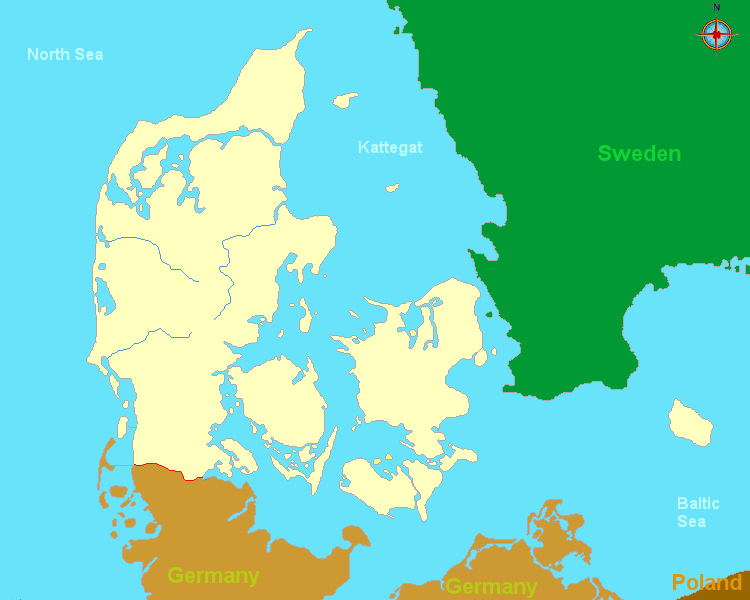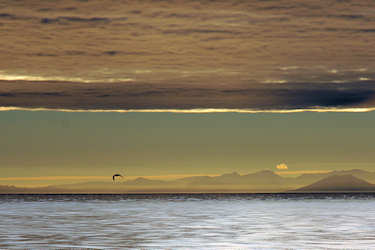Denmark

Historie
The Weichsel glaciation covered all of Denmark most of the time, except the western coasts of Jutland. It ended
around 13.000 years ago, allowing humans to move back into the previously ice-covered territories and establish permanent habitation.
During the first post-glacial millennia, the landscape gradually changed from tundra to light forest, and varied fauna including
now-extinct megafauna appeared. Early prehistoric cultures uncovered in modern Denmark include the Maglemosian culture
(9.500–6.000 BC); the Kongemose culture (6.000–5.200 BC), the Ertebølle culture (5.300–3.950 BC), and the
Funnelbeaker culture (4.100–2.800 BC).
The Nordic Bronze Age (1800–600 BC) is a successor of the Corded Ware culture (3000-2350 BC)in southern Scandinavia and
Northern Germany, as well as from influence that came from Central Europe. The people of the Nordic Bronze Age were actively engaged in
the export of amber, and imported metals in return, becoming expert metalworkers. With respect to the number and density of metal
deposits, the Nordic Bronze Age became the richest culture in Europe during its existence.
During the Pre-Roman Iron Age (500 BC – AD 1), native groups began migrating south, and the first tribal Danes came to the
country. Historians believe that before their arrival, most of Jutland and the nearest islands were settled by tribal Jutes.
The Jutes migrated to Great Britain eventually, some as mercenaries of Brythonic King Vortigern, and were granted the south-eastern
territories of Kent, the Isle of Wight and other areas, where they settled.
From the 8th to the 10th century, the Danes were known as Vikings. Together with Norwegians and Swedes,
they colonised, raided and traded in all parts of Europe. Viking explorers first discovered Iceland by accident in the
9th century, on the way towards the Faroe Islands and eventually came across "Vinland" (Land of wine) also known
today as Newfoundland, in Canada. The Danish Vikings were most active in the British Isles and Western Europe. They
temporarily conquered and settled parts of England, Ireland and France where they founded Normandy. In the early 11th century
Canute the Great united Denmark, England and Norway for almost 30 years. England broke away from Danish control in 1035 and Denmark
fell into disarray for some time.
In the early 12th century, Denmark became the seat of an independent church province of Scandinavia. Not long after that, Sweden and Norway
established their own archbishoprics, free of Danish control. The mid-12th century proved a difficult time for the Kingdom of Denmark.
Violent civil wars rocked the land. Eventually, Valdemar the Great (1131–82), gained control of the kingdom, stabilizing it and
reorganizing the administration. King Valdemar and Absalon (ca 1128–1201), the bishop of Roskilde, rebuilt the country.
Valdemar and Absalon built Denmark into a major power in the Baltic Sea, a power which later competed with the Hanseatic League,
the counts of Holstein, and the Teutonic Knights for trade, territory, and influence throughout the Baltic. In 1168,
Valdemar and Absalon gained a foothold on the southern shore of the Baltic, when they subdued the Principality of Rügen.
In 1202, Valdemar II became king and launched various "crusades" to claim territories, notably modern Estonia. Once these efforts
were successful, a period in history known as the Danish Estonia began.
In 1397, Denmark entered into the Kalmar Union (1397-1523) with Norway and Sweden, united under Queen Margaret I. The three
countries were to be treated as equals in the union. However, even from the start Margaret may not have been so idealistic treating Denmark
as the clear "senior" partner of the union. Thus, much of the next 125 years of Scandinavian history revolves around this union,
with Sweden breaking off and being re-conquered repeatedly.
After Sweden permanently broke away from the Kalmar Union in 1523, Denmark–Norway (1536-1814) was created.
The Dano-Norwegian Kingdom grew wealthy during the 16th century, largely because of the increased traffic through the Øresund, which Danes
could tax because Denmark controlled both sides of the Sound. The trade in grain exports from Poland to the Netherlands and to the rest of
Europe grew enormously at this time, and the Danish kings did not hesitate to cash in on it.
In 1643, Sweden's armies, under the command of Lennart Torstensson, suddenly invaded Denmark without declaring war. The ensuing conflict became
known as the Torstenson War. The NetherlandsBattle of Femern.
The result of this defeat proved disastrous for Denmark–Norway: in the Second treaty of Brömsebro (1645) Denmark ceded to Sweden Gotland,
the last parts of Danish Estonia, and several provinces in Norway. Halland went to Sweden for a period of 30 years and the Netherlands
were exempted from paying the Sound Duty.
In the Napoleonic Wars (1803–1815), Denmark traded with both France and the United Kingdom and joined the League of Armed Neutrality
with Russia, Sweden, and Prussia. The British considered this a hostile act and attacked Copenhagen in 1801 and 1807, in one case carrying
off the Danish fleet, in the other, burning large parts of the Danish capital. This led to the so-called Danish-British Gunboat War
(1807–1814). British control of the waterways between Denmark and Norway proved disastrous to the union's economy and in 1813 Denmark–Norway
went bankrupt.
The union was dissolved by the Treaty of Kiel in 1814; the Danish monarchy "irrevocably and forever" renounced claims to the
Kingdom of Norway in favour of the Swedish king. Denmark kept the possessions of Iceland, the Faroe Islands and Greenland,
all of which had been governed by Norway for centuries.
The Danish liberal and national movement gained momentum in the 1830s, and after the European Revolutions of 1848 Denmark peacefully became
a constitutional monarchy on 5 June 1849.
Denmark remained neutral during World War I, but the conflict affected the country to a considerable extent. As its economy was heavily
based on exports, the unrestricted German submarine warfare was a serious problem. Denmark had no choice but to sell many of its exports to
Germany instead of overseas nations.
In 1939 Denmark signed a 10-year non-aggression pact with Nazi Germany but Germany invaded Denmark on 9 April 1940 and the Danish
government quickly surrendered. World War II in Denmark was characterised by economic co-operation with Germany until 1943, when
the Danish government refused further co-operation and its navy scuttled most of its ships and sent many of its officers to Sweden, which
was neutral.
In 1973, along with Britain and Ireland, Denmark joined the European Economic Community (now the European Union) after a public referendum.
I have visited Denmark several times.
The pictures of these trips, are not yet available; i have to digatalize them first.
In september 2013 i have visit Greenland
Please let me know when you're having questions.
i would be pleased to help you.
Things to do and other tips
